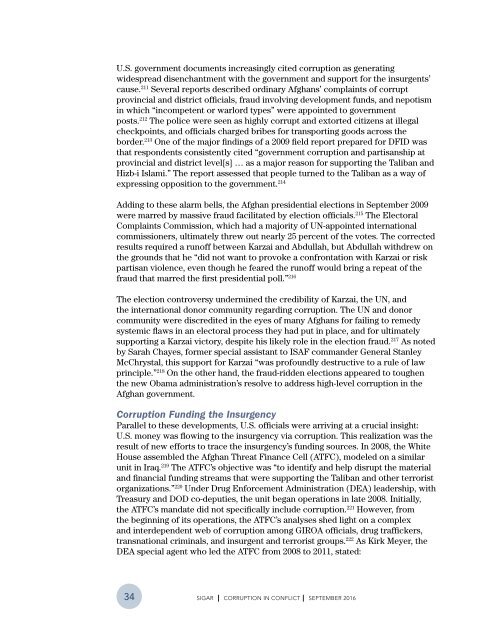CORRUPTION IN CONFLICT
5IlaWjQej
5IlaWjQej
Create successful ePaper yourself
Turn your PDF publications into a flip-book with our unique Google optimized e-Paper software.
U.S. government documents increasingly cited corruption as generating<br />
widespread disenchantment with the government and support for the insurgents’<br />
cause. 211 Several reports described ordinary Afghans’ complaints of corrupt<br />
provincial and district officials, fraud involving development funds, and nepotism<br />
in which “incompetent or warlord types” were appointed to government<br />
posts. 212 The police were seen as highly corrupt and extorted citizens at illegal<br />
checkpoints, and officials charged bribes for transporting goods across the<br />
border. 213 One of the major findings of a 2009 field report prepared for DFID was<br />
that respondents consistently cited “government corruption and partisanship at<br />
provincial and district level[s] … as a major reason for supporting the Taliban and<br />
Hizb-i Islami.” The report assessed that people turned to the Taliban as a way of<br />
expressing opposition to the government. 214<br />
Adding to these alarm bells, the Afghan presidential elections in September 2009<br />
were marred by massive fraud facilitated by election officials. 215 The Electoral<br />
Complaints Commission, which had a majority of UN-appointed international<br />
commissioners, ultimately threw out nearly 25 percent of the votes. The corrected<br />
results required a runoff between Karzai and Abdullah, but Abdullah withdrew on<br />
the grounds that he “did not want to provoke a confrontation with Karzai or risk<br />
partisan violence, even though he feared the runoff would bring a repeat of the<br />
fraud that marred the first presidential poll.” 216<br />
The election controversy undermined the credibility of Karzai, the UN, and<br />
the international donor community regarding corruption. The UN and donor<br />
community were discredited in the eyes of many Afghans for failing to remedy<br />
systemic flaws in an electoral process they had put in place, and for ultimately<br />
supporting a Karzai victory, despite his likely role in the election fraud. 217 As noted<br />
by Sarah Chayes, former special assistant to ISAF commander General Stanley<br />
McChrystal, this support for Karzai “was profoundly destructive to a rule of law<br />
principle.” 218 On the other hand, the fraud-ridden elections appeared to toughen<br />
the new Obama administration’s resolve to address high-level corruption in the<br />
Afghan government.<br />
Corruption Funding the Insurgency<br />
Parallel to these developments, U.S. officials were arriving at a crucial insight:<br />
U.S. money was flowing to the insurgency via corruption. This realization was the<br />
result of new efforts to trace the insurgency’s funding sources. In 2008, the White<br />
House assembled the Afghan Threat Finance Cell (ATFC), modeled on a similar<br />
unit in Iraq. 219 The ATFC’s objective was “to identify and help disrupt the material<br />
and financial funding streams that were supporting the Taliban and other terrorist<br />
organizations.” 220 Under Drug Enforcement Administration (DEA) leadership, with<br />
Treasury and DOD co-deputies, the unit began operations in late 2008. Initially,<br />
the ATFC’s mandate did not specifically include corruption. 221 However, from<br />
the beginning of its operations, the ATFC’s analyses shed light on a complex<br />
and interdependent web of corruption among GIROA officials, drug traffickers,<br />
transnational criminals, and insurgent and terrorist groups. 222 As Kirk Meyer, the<br />
DEA special agent who led the ATFC from 2008 to 2011, stated:<br />
34<br />
SIGAR I <strong>CORRUPTION</strong> <strong>IN</strong> <strong>CONFLICT</strong> I SEPTEMBER 2016


